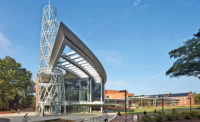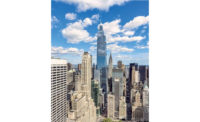
At a height of 274.9 ft, a new air traffic control tower for Chhatrapati Shivaji International Airport in Mumbai is India's tallest control tower. The high-tech structure, intended as an architectural icon and symbol of India's advancement, currently ranks as the fourth tallest control tower in the world.
Next year, when a 446-ft-tall tower under construction in Jeddah opens, the $16-million Mumbai tower will fall to fifth place in the ranking. The current tallest is the 361-ft tower at Cairo's airport, according to a list compiled by Rick Brown of Panethos.
The tower is nowhere near the height of India’s two tallest buildings. The Imperial I and II, also in Mumbai, stand 827 ft, according to Emporis.
The control tower will afford controllers unobstructed views of the airport's entire operational area. The goal is to optimize air traffic separation and increase air traffic handling capacity.
Designed by the Hong Kong office of HOK, with multidisciplinary engineer Arup, the structure consists of three glass-clad levels at the base and four at the top, including the “cab.” The occupied levels are built around a structural concrete core. A “wishbone-like” structure—the tower's splayed legs flanking the core—is designed to reduce wind vibrations at high altitudes. The tower’s taper also helps reduce the perceived mass of the cab, says the architect.
The tower's roof truss, which cantilevers 55.8 ft, was a “complicated bolted structure,” says Anshul Singhal, director, JSW Severfield Structures Ltd (JSSL), which was responsible for the structure’s connection design, fabrication, material supply and erection of the structural steel, metal decking and fire proofing. “Partial preassembly of the truss was done at the plant and thoroughly checked before welding the components.”
The platform structure was erected in close coordination with the core's concrete work. “After erecting each platform, the central concrete core would go up and the next level platform was erected,” says Singhal.
Building information modeling "proved useful for the accuracy of fabrication and erection,” adds Singhal. However, after completing the entire model, the sizes of structural members had to be changed to accommodate the additional load from the roof, he says.
GVK Reddy, executive chairman of GVK MIAL, which developed the tower for the India Airports Authority of India, says the tower represents an aspiration to transform India and Mumbai by creating “iconic structures to adorn the city and India’s landscape. It is a precursor to the new integrated terminal coming up soon.”





